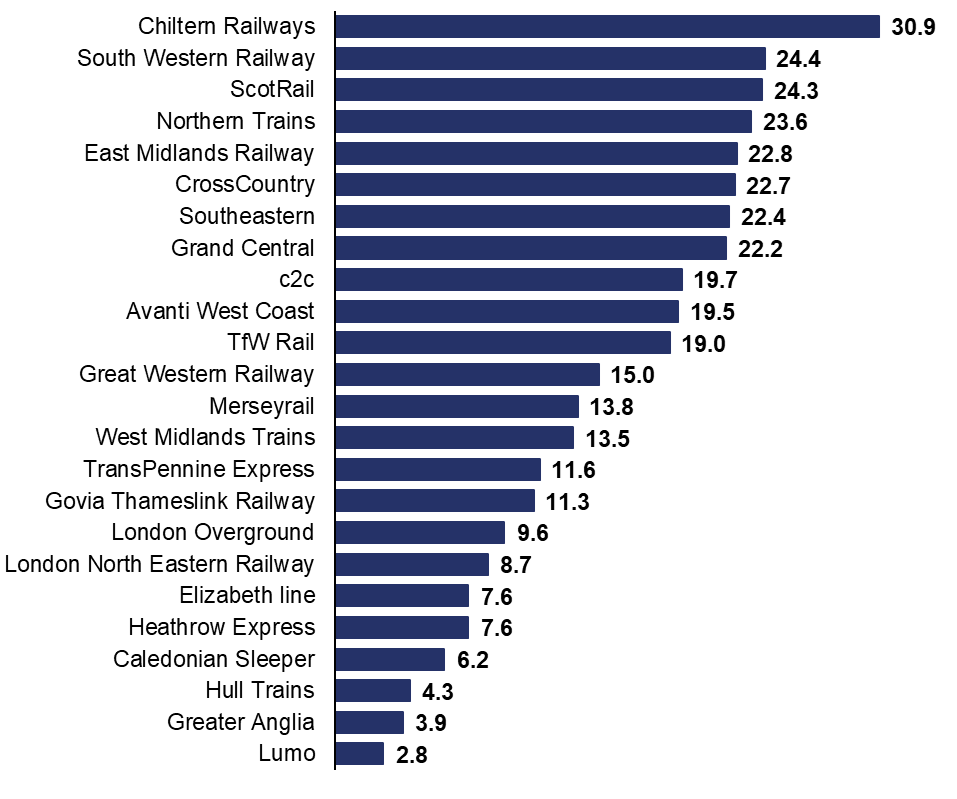Office of Rail and Road
|
|
Passenger rolling stock: why has average age decreased?
We explain what factors influence changes in the average age of rolling stock.

Each year ORR publishes statistics on the average age of rolling stock for each rail operator in Great Britain.
The train fleet in Great Britain
Did you know there are more than 15,000 vehicles in the national railway fleet? The oldest rolling stock was built in the 1970s and is now operated by Chiltern Railways. Newer examples include Transport for Wales’ Class 197 vehicles which took to the tracks in 2022, on the Wales and Borders service.
Rolling stock in the last 10 years
The average age of rolling stock has changed over time. Ten years ago (year ending March 2014), the average age for franchised stock in Great Britain was 19.4 years, however, as of 31 March 2024, this decreased to 16.6 years. This reflects the introduction of newer rolling stock and the removal of older vehicles. Over this time period, some older fleets have been refurbished to increase capacity, and also to meet new accessibility standards, so this average age doesn’t necessarily reflect the comfort or accessibility of this stock.
Average age of rolling stock in years (franchised operators), Great Britain, as of 31 March, 2008 to 2024

The average age varies substantially by operator. As of 31 March 2024, Lumo had the lowest average age of their vehicles at 2.8 years, while Chiltern Railways had the oldest fleet with an average age of 30.9 years.
Average age of rolling stock in years by operator, Great Britain, as of 31 March 2024

What drives the changes in average age?
A rail vehicle has a typical service life of around 30 to 35 years. Therefore, after a period of investment in new stock, the average age will rise for a number of years before the next wave of replacement vehicles is introduced to bring the average age back down.
Between 31 March 2014 and 31 March 2024, the average age of rolling stock for franchised operators decreased by 2.73 years - down from 19.35 years to 16.62 years. Any rolling stock in use as of 31 March 2013 which was still in use as of 31 March 2024 would have aged 10 years, meaning that without the addition of any new stock, the average age would have increased by 10 years. Therefore, the decrease of 2.73 years reflects train operators either introducing newer rolling stock, retiring older rolling stock, or a combination of these measures.
These statistics are a measure of the age of a vehicle, and because rail vehicles have a long service life, an important factor for customers is how the train is maintained and refurbished over its life to improve the experience on board the train.
Transport Focus runs a network-wide survey to collect opinions of train services on a bi-weekly basis. As of 30 March 2024, 82% of passengers reported themselves as either fairly satisfied or very satisfied with the train that they travelled on, while 80% were either fairly or very satisfied with the comfort of their seats.
What do we publish?
Each year, ORR publishes its annual Rail Infrastructure and Assets statistical release. This contains the latest data on the average age of rolling stock, as well as the traction type of these vehicles (electric, diesel, bi-mode or locomotive hauled). This also includes information on the length of the network, track electrification and the number of mainline stations.
The data source for the average age of rolling stock statistics is the R2 database, which is maintained by RSSB. R2 holds details of every vehicle registered to operate on the Great Britain railway, and is the single repository for all vehicles and major components with full maintenance history.
Related links
Rail Infrastructure and Assets, April 2023 to March 2024
Original article link: https://www.orr.gov.uk/search-news/passenger-rolling-stock-why-has-average-age-decreased
.gif)

